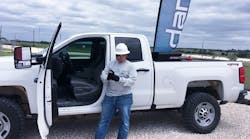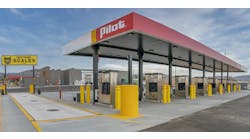Fleets don’t need events such as the Colonial Pipeline hack and subsequent fuel shortage in the South to spur a search for new ways to improve fuel efficiency. Fleet management and maintenance leaders are always on the lookout for those. After all, the less fuel a vehicle consumes, the lower that owner’s gas and diesel bills are. These trucks and vans’ internal combustion engines also incur less wear and tear—and downtime—leading to additional savings.
At some point, fleets may decide to move to electric vehicles, which subsist on electricity and have far fewer moving parts to maintain. For now, they have to get creative once they have plucked all the low-hanging fruit, such as spec’ing more efficient engines and low rolling resistant tires, or using cruise control. At some point, they need to climb a few more branches higher.
There they may find Derive’s VQ Efficiency platform, a software solution that recalibrates and optimizes a Class 1-6 engine for a specific region or route. Temperature and topography vary greatly across North America, and Derive acts as a digital tailor to adjust an engine’s rpm to fit the operating area. The results are noticeable reductions in fuel consumption and emissions.
“On average, we're seeing things like 6% to 10%, and a lot of our customers are seeing 10 to 15% fuel reduction,” Derive CEO H. John Oechsle said. “We're also seeing reductions in the carbon footprint on a dramatic basis—2.9 cubic tons of CO2 per vehicle per year.”
Oechsle, who took the executive role at Derive, based out of Broomfield, Colorado, a day before the COVID lockdowns took hold in March 2020, called the VQ Efficiency platform “a bridge” between I.C.E. engines and EVs, as the production of commercial EVs is just ramping up “and the charging infrastructure needed in order to get us there is going to take years, if not decades.”
Previously Derive had been known for its engine calibration expertise in tuning performance cars for more speed and torque. Derive began its fleet management business in 2010, performing 2 million installations. Oechsle said the Efficiency platform, which can be used alone or in conjunction with its Safety and Telematics platforms, is available for 62% of fleet vehicles, with MY2013 generally being the oldest vehicles to use it. Private fleet Safelite has been using Derive technology since 2013, with 6,500 of its windshield repair vehicles benefiting from the calibration software.
According to Derive, Safelite vans saved nearly 11 gallons of fuel per month, which as gas prices climb, will equal more savings. Emissions savings were 1.27 tons of CO2 per vehicle per year. Across Safelite's fleet, this means 95,450 tons were removed in a year, the equivalent of taking out 562 vans' emissions.
The way it works is that a technician, either from the fleet or a fleet management company, will attach a Derive device into the OBD-II port. The firmware then communicates with the vehicle’s electronic control unit (ECU), and Derive overwrites the current tables controlling engine rpm to what Derive has found to be more efficient for that region. Speed limiters can also be added for safety as well as efficiency. It’s typically a one-time, 30-minute install, though if the vehicle changes operating areas, it might need to be recalibrated.
“If somebody is going to be driving in the mountains, there has to be a slight tweak to the calibration, because they may need a little bit more power. If they're in Las Vegas in the summertime, it's going to be super hot, so we adjust idle speed,” Oechsle explained.
After a successful pilot program, oil and gas service company Danos decided to deploy Efficiency VQ on 400 of its 450 units, which are mostly GM and Ford three-quarter- and half-ton pickups. The vehicles are used to transport crews out on the Permian Basin oilfields in West Texas, as well as areas of Louisiana and Pennsylvania.
Danos fleet manager Amanda Worrell confirmed the company’s vehicles are falling within the range of 6 to 10% fuel efficiency. Danos’ trucks are also speed governed to 75 mph through VQ Efficiency.
Fleets can monitor their performance on a dashboard called Mission Control. Worrell said more data needs to be collected to truly understand how much the engine-tweaking may benefit terrains similar to those in the pilots, but she did say the ROI is fast.
“Within year one, it actually it balances out,” Worrell said. “So the longer we maintain Derive in the fleet, then it's almost as if Derive is paying Danos to run its software.”
More recently, Danos has done some solar work in Arizona and Texas, highlighting the company’s sustainability goals.
“Reducing our carbon footprint is one of the big challenges these days; everybody is looking how to make themselves a greener company,” she said.
One big reason is that Danos’ customers include major oil companies, who have made their own public-facing statements about reaching carbon neutrality. If Danos were not as laser-focused on reducing emissions, they risk jeopardizing their partnerships.
Danos found the software does save 2.95 tons of CO2 per vehicle annually. Extrapolated to the fleet level, Danos will remove 1,178 tons of CO2 per year. That equates to eliminating 28 vehicles’ emissions, or 7% of its fleet.
And every small step helps on the journey to sustainability.
“The more money that we're able to save on fuel, then we're able to invest in other technologies,” Worrell said. “Because we are technology-driven, we're always looking to improve and to find the next thing, to be ahead of the curve.”





